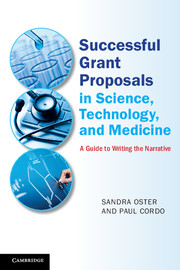Book contents
- Frontmatter
- Dedication
- Contents
- Preface and Acknowledgments
- 1 The Scientific Grant Proposal and Its Narrative
- 2 The Aims Section
- 3 The Background Section
- 4 The Preliminary Studies/Progress Report Section
- 5 The Methods Section, Part 1
- 6 The Methods Section, Part 2
- 7 Other prose considerations
- 8 Technical features of sentences
- Glossary
- Index
- References
1 - The Scientific Grant Proposal and Its Narrative
Published online by Cambridge University Press: 05 September 2015
- Frontmatter
- Dedication
- Contents
- Preface and Acknowledgments
- 1 The Scientific Grant Proposal and Its Narrative
- 2 The Aims Section
- 3 The Background Section
- 4 The Preliminary Studies/Progress Report Section
- 5 The Methods Section, Part 1
- 6 The Methods Section, Part 2
- 7 Other prose considerations
- 8 Technical features of sentences
- Glossary
- Index
- References
Summary
A scientific grant proposal is a request for funds to conduct original research in a discipline or a subject area typically associated with science, technology, or medicine. A principal investigator (PI) is the researcher who is responsible for the content of a scientific grant proposal and for submitting it to a funding agency on time, and who will be responsible for directing, developing, and executing the research on time. The PI is usually the person writing most of the narrative, if not the entire scientific grant proposal. The narrative comprises the major prose sections of the scientific grant proposal, including the abstract.
There may also be co-investigators (Co-Is) who help the PI design and develop the proposed research and write the narrative, and who will help the PI execute the research. Sometimes there are collaborators who will perform a significant part of the research and are, to a certain degree, responsible for designing their limited portion of the proposed research, subject to the PI’s approval. Finally, there may be contractors hired to perform a relatively small portion of the research, but who have not helped in designing or developing the research project.
There are many very good resources on the market dealing with strategies and other information to select funding mechanisms from public and private agencies that support scientific, technical, and medical research. However, there are far fewer resources dealing with how to write the narrative of the scientific grant proposal that describes and argues for the proposed research.
- Type
- Chapter
- Information
- Successful Grant Proposals in Science, Technology, and MedicineA Guide to Writing the Narrative, pp. 1 - 35Publisher: Cambridge University PressPrint publication year: 2015



